The Rushlight Club 2013 Fall Meeting Report, October 4th, 5th, and 6th, Doylestown PA
Fall 2013 meeting at Mercer Museum spotlights unusual lighting collections
by Martha O. DeBlieu
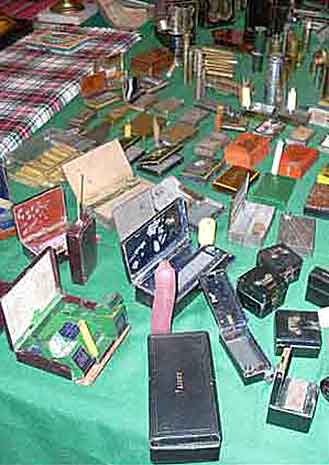
Unique lighting, structures, and private collections drew roughly 55 Rushlight members to the Fall 2013 meeting events at the Mercer Museum in Doylestown, Pa., and nearby New Hope, Pa., and Ringoes, N.J., Oct. 4th to 6th.
Members Dave and Polly Carl opened their Ringoes, N.J., home for viewing their unique, jam-packed collection of lighting and antique furnishings. Dating back to 1690, the house provided a stunning backdrop for the eclectic collection which spanned early colonial ironwork and unique candlesticks to Sandwich patterned glass lamps, a diverse array of 19th and 20th century lanterns and lighting; and interesting curios.
On Saturday, Dan Sohn brought the May 31, 1889 Great Flood in Johnstown to life. He used eyewitness accounts to describe vividly the "twilight of terror" and how fire, lighting, and fuel brought both comfort and fear.
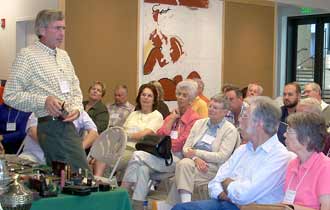
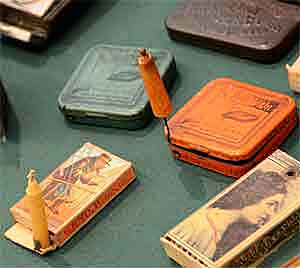
Ed Klausmeyer showed and discussed a wide array of varying "travel lamps", from small tinderboxes, tin devices with attached extinguishers, and small portable candle holders to 19th century pocket lighting devices, larger portable lights more suitable for desks or tables, and "Rube Goldberg-like" mechanized devices holding tiny matches and wicks.
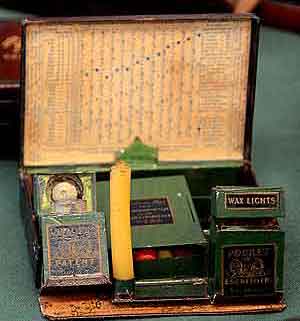
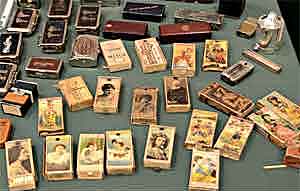
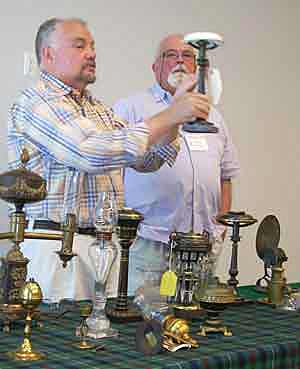
Some devices were designed to produce enough heat to get sealing wax bubbly, while others were developed to just give a short amount (two to four minutes) of light or spark. Some included storage for paper or stamps; one had a moon and almanac celestial chart.
J. Craig Maue and Keith Letsche displayed about 20 key lamps from Maue's collection and shared their historical significance. They included:
- four Argand lamps, including a single arm Argand lamp with single Greek key font, similar to one at Mt. Vernon; an intact late 18th century full-size stand Argand lamp with Liverpool button, period prisms, and original bronze & bright finish; plus a miniature English stand Argand lamp with three animal paw feet and bronze and bright finish;
- a miniature or baby sinumbra lamp made by William Carlton of Boston, plus a Carlton gas portable lamp;
- a brass lamp similar to a Miles Patent lamp but with a drop burner and another brass hand lamp marked "Jesse Neal Patent, S.H. Judd, Waterbury, Ct - Agt For New England."
- several solar lamps, including a never-burned Boston-manufactured, five-inch solar lamp with period globe and a circa-1850s Baker and Arnold aesthetic-style solar lamp with a copper and brass base and 1870s European acid finish globes.
- a tiny ship's gimbaled lamp with a double burner and an 1850 bracket whale oil lamp;
- a hard-to-find Cornelius and Baker chamberstick with extinguisher.
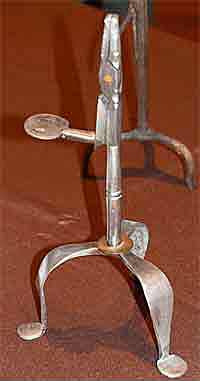
Following lunch, members Peter Gregory and Chuck Leib engaged members in identifying objects from the museum's collection and their use. These included reproduction rush holders, a grease lamp of cast brass similar to the Southwark patent, a Perry patent lamp that some thought might be an early Tomlinson patent lamp; a whale oil lamp with hook; a Davis patent lamp that was missing its wick pick chain; a Drummond patent lard oil lamp; a Stonesifer tin lamp with the wrong key attached; an 1870s ballot box; a Gleason-style double-walled pewter whale oil lamp; and an 1865 patent lantern and footwarmer.
Members browsed the Mercer Museum with its examples from a wide range of industries and crafts and toured Henry Chapman Mercer's unique poured reinforced concrete castle-like home, Fonthill. Built between 1908 and 1912, the National Historic Landmark incorporates specialty tiles from his Moravian Pottery and Tile Works throughout the 44 rooms and includes nearly 6,000 books annotated by Mercer, artwork and prints, and other artifacts from his world travels, including cuneiform tablets dating to 2300 BC.
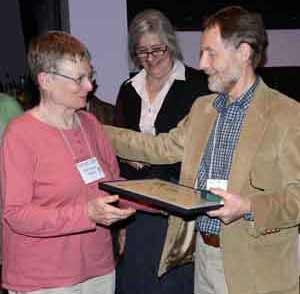
Saturday evening featured the membership meeting, including officer elections and banquet. The Rushlight magazine editor, Marianne Nolan, was recognized for her 35-plus years of service.
Donald Linebaugh, author of The Springfield Gas Machine: Illuminating Industry and Leisure, 1860s-1920s, traced the history, mechanics, and benefits of this machine - which brought light to rural and outlying communities, newly built homes, colleges, resorts, and companies. Made and sold by the Massachusetts-based Gilbert and Barker Manufacturing Co., the system popularized the use of gas discarded from crude oil refining as a viable fuel source. Initially a weight-driven air pump and gas generator, the system was later improved with a cold process design with two separate components; an air pump in the building and an underground vault-protected gasoline generator outside the building. Well-known sites and homes where it was used included Edison Machine Works and Lamp Co. By 1929, ads for the Springfield Gas Machine disappeared, although some systems remained in operation until the 1950s.
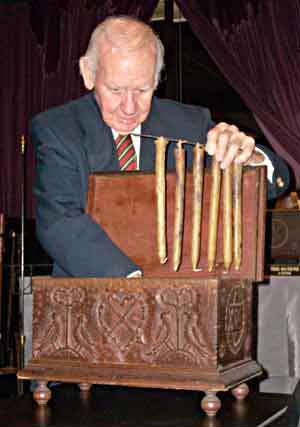
Former President Frank Walton brought about 24 unique show-and-tell items, including splint holders; two Rushlight stands (a Queen-Anne style floor stand and a scarce wall holder); cast iron open font two-wick holder lamp featured in Early Lighting I; six different types of Betty lamps (including a Peter Derr, an 1850 John Long marked lamp with handturned stand similar to one in the Philadelphia Museum of Art, and unusual double-headed swan open Betty); tin with wood base two-candle ratchet table lamp; a three-lamp combination holder (rush betty, and candle); several types of candle stands; a redware fat lamp; a large Pennsylvania Dutch-style carved wooden candle box; and a silver nightlight similar to one sold at auction for $7,000.
The Rushlight Club Inc. www.rushlight.org